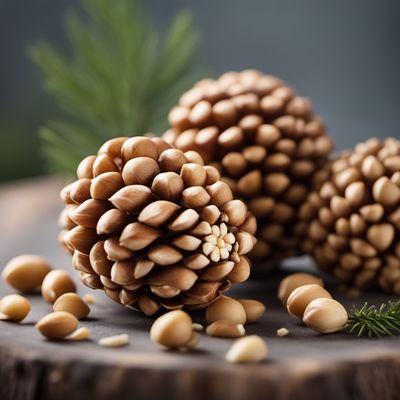
Ingredient
Pine nut kernels and similar-
The Nutty Delicacy: Pine Nut Kernels
Pine nut kernels are small, elongated seeds with a pale ivory color and a teardrop shape. They have a delicate texture and a rich, buttery taste. The flavor profile is often described as slightly sweet and nutty. Pine nut kernels are typically harvested from specific pine tree species, such as the stone pine or Korean pine.
Origins and history
Pine nut kernels have a long history of culinary use and have been enjoyed for thousands of years. They are native to regions with pine forests, including Europe, Asia, and North America. In Mediterranean cuisine, pine nuts are a key ingredient in dishes like pesto sauce and baklava. They are also widely used in Middle Eastern, Asian, and North African cuisines.
Nutritional information
Pine nut kernels are a good source of healthy fats, protein, and various vitamins and minerals. They are particularly high in vitamin E, magnesium, and manganese. However, they are also relatively high in calories, so portion control is important when consuming them.
Allergens
Pine nut kernels may cause allergic reactions in some individuals, particularly those with tree nut allergies. It is recommended to exercise caution and consult with a healthcare professional if you have known allergies.
How to select
When selecting pine nut kernels, look for nuts that are plump, uniform in size, and free from discoloration or mold. Shake the container to ensure there are no rattling sounds, which could indicate stale or empty shells. It is best to purchase pine nuts in small quantities to ensure freshness.
Storage recommendations
Pine nut kernels should be stored in an airtight container in the refrigerator to prevent them from turning rancid. They can also be stored in the freezer for longer-term storage. Proper storage will help maintain their freshness and prevent spoilage.
How to produce
Pine nut trees can be grown in suitable climates, but they require patience as they take several years to produce nuts. They prefer well-drained soil and full sun. However, due to their slow growth and specific environmental requirements, it may be more practical to purchase pine nut kernels from stores or online suppliers.
Preparation tips
Pine nut kernels can be used in a variety of culinary applications. They are commonly used in pesto sauce, salads, pasta dishes, and baked goods. They can also be toasted and sprinkled over roasted vegetables or used as a topping for desserts. Pine nuts are a key ingredient in traditional dishes like Italian pignoli cookies and Middle Eastern pilaf.
Substitutions
Almonds, cashews, or sunflower seeds can be used as substitutes for pine nut kernels. While they may not have the exact same flavor and texture, they can provide a similar nuttiness and crunch to dishes.
Culinary uses
Pine nut kernels are widely used in Mediterranean cuisine, particularly in Italian and Middle Eastern dishes. They are also popular in other global cuisines, including Asian and North African. From pesto to desserts, pine nuts add a unique flavor and texture to a wide range of recipes.
Availability
Pine nut kernels are commonly available in regions with pine forests, including Europe, Asia, and North America. They are also widely imported and exported, making them accessible in many countries around the world.
